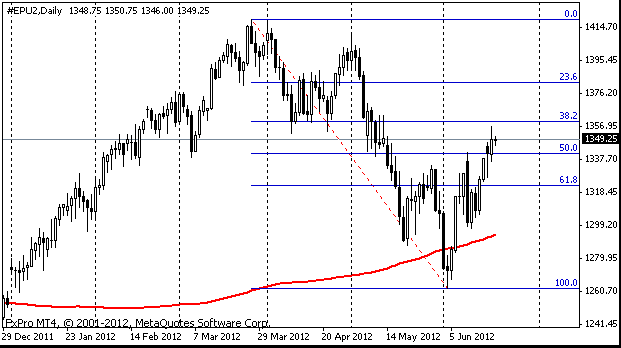EUR/usd
The euro slumped during the EU session yesterday and continued the decline this morning. We can observe the formation of a double top above the level of 1.26 and the rates are now close to 1.2530. The newsfeeds describe this move down as a risk-aversion impulse on the concerns that the ECB's actions won't be as large-scale as expected earlier. We believe that yesterday's move shouldn't be fussed about, as EUR/USD remains within the upward channel and, moreover, is half a handle below its boundary. A good rally is often preceded by a slight drop, which makes buying of the instrument more attractive and also gathers stop-orders at the bottom. There wasn't much news from Europe yesterday, so the markets were moved mainly by technical factors and their own mood. As we mentioned yesterday, the pair‘s fluctuations above 1.24 will still indicate the dominating bullish sentiment. However, the drop lower will already be a cause for concern, meaning a probable reversal of the current trend. The latter can occur in case of a huge discrepancy between expectations and actual actions, which will be voiced by draghi tomorrow. As you remember, the ECB is expected to introduce a plan, describing the mechanism which will support the EU peripheral debt markets and be an effective deterrent against growth of European bond yields. It is also expected that the mechanism won't be launched till September 12 when the German Constitutional Court will decide on the legitimacy of the ESM's financing (at Germany's expense as well). It's also worth mentioning that the US Manufacturing PMI has proved to be worse than estimated before. It has been revised from 51.9 down to 51.5 in August. In the meantime the more respected ISM Manufacturing PMI hasn't managed to go positive and remained below 50. Its recent value makes 49,6 and is the highest level since July 2009 (the analogies with the nasty 2009 have now spread to the USA). This cannot be an omen of favourable employment statistics.

GBP/USD
The general tendency for a retracement hasn't left the British currency unaffected. GBP/USD has faced profit-taking and its quotes have dropped down to 1.5850. So, the level of 1.59 remains unconquered. Even the early release of the Services PMI statistics has failed to help the sterling. The data demonstrated an impressive growth of the British service sector in August – the index has grown from 51.0 last month to 53.7. We again emphasize that this doesn't promise the GDP growth, as the same or even higher figures have been observed since the end of the previous year, nevertheless the economy has been slowing down for three quarters in a row.

AUD/USD
Australia risks becoming like most other developed countries in terms of growth. The GDP data published this night proved to be poorer than expected – growth by just 0.6% against the forecasted 0.8% and 1.4% in the first quarter this year. Thus the annual growth rate has also dropped. Now it makes 3.7%. It is really much, perhaps, for any developed country now and for half of the developing ones, however Australia was expected to show a better performance. Yesterday's upward retracement in the aussie proved to be short-lived. Today AUD/USD has fallen below 1.02. Apparently, the drop of iron ore prices has produced a strong influence on the money inflows and the national welfare funds, which were actively purchasing the Aussie before, have stopped to be that eager about it now.

The disappointing poor data on the US manufacturing PMI have put a pressure on the American stock exchanges. S&P 500 again went below 1400 yesterday. Already for three weeks in a row the charts have been showing the support at 1395 and the resistance slipping down with the peaks on August 21, 27 and 31 and September 4. The tendency doesn't seem to be reassuring, at the same time it is clear that the market isn't going to enter the QE phase being overbought.
